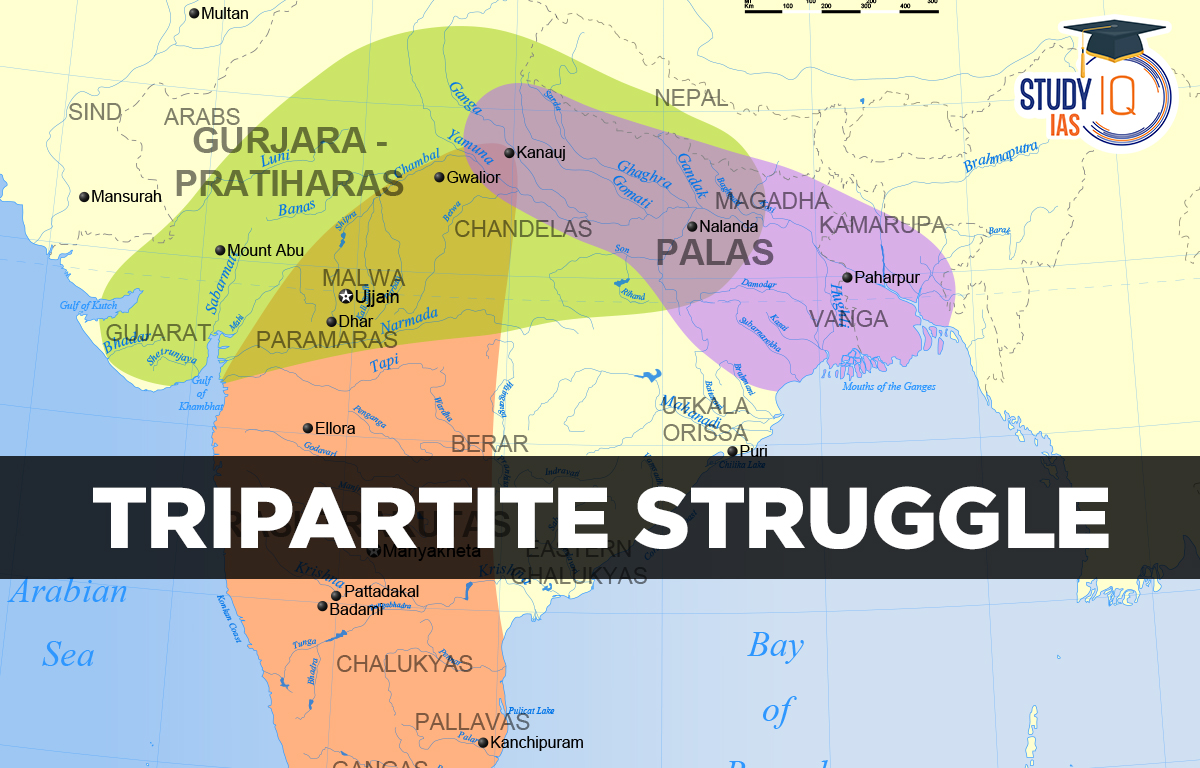Table of Contents
The Tripartite Struggle (8th–12th century CE) was a prolonged conflict among three major Indian dynasties—the Gurjara-Pratiharas, Palas, and Rashtrakutas—for control over the fertile and strategically significant region of Kannauj in northern India. This struggle had profound impacts on India’s medieval political landscape and is a key topic in the history syllabus for UPSC.
What was the Tripartite Struggle?
The Tripartite Struggle, also known as the Kannauj Triangle Wars, refers to the conflict among three powerful Indian dynasties—the Rashtrakutas, Pratiharas, and Palas—for control over the strategically important city of Kannauj in northern India. Situated on the Ganga trade route, Kannauj held immense strategic and economic importance, and its possession promised influence over northern India.
This conflict, lasting for nearly two centuries, is significant for the power dynamics it introduced, as well as for the military and cultural advancements that occurred during the period.
Read about: Indian National Army
Historical Background of Tripartite Struggle
The roots of the Tripartite Struggle can be traced back to the fall of the Harsha Empire in the mid-7th century. After the death of Emperor Harshavardhana, the once-unified northern Indian region fragmented into smaller, competing states. Northern India lacked a central political authority, which gave rise to ambitions among various regional powers.
Among these powers, the three most prominent dynasties—the Pratiharas, Palas, and Rashtrakutas—aspired to fill the political vacuum left by Harsha. Control of Kannauj, a city located on the Ganga trade route, was seen as the key to dominance in the region.
Main Causes of Tripartite Struggle
Several factors contributed to the Tripartite Struggle. Here are the main reasons:
1. Strategic Importance of Kannauj
Kannauj was centrally located on the Ganga trade route, which linked it to the lucrative Silk Road. This made the city a hub for trade and commerce, giving it both economic and military significance. Additionally, Kannauj had previously been the capital of Harsha’s empire, adding prestige to whoever controlled it.
2. Disintegration of the Harsha Empire
With the collapse of the Harsha Empire in the 7th century, northern India became politically fragmented. Several regional powers emerged, with no single dynasty powerful enough to dominate the region. This vacuum led to increased competition among the Pratiharas, Palas, and Rashtrakutas for supremacy.
3. Economic Motivations
The collapse of the Silk Route and the disruption of trade channels further escalated the struggle. Control over Kannauj would offer access to rich trade revenues, which would bolster the economic strength of the ruling dynasty.
4. Desire for Political Supremacy
The ambition to control Uttarapatha (northern India) led to a rivalry between these three empires. Each dynasty sought the title of “Sakalottarapathanatha” (Lord of North India) or “Uttarpathaswami.”
Phases of Tripartite Struggle
The tripartite Struggle can be divided into three significant phases:
1. First Phase (1761-1799)
- Battles of Panipat (1761): Marked the beginning of the Maratha decline with a significant defeat against the Afghan forces.
- Rise of Mysore: Hyder Ali emerged as a dominant force in southern India, challenging both the Marathas and the British.
2. Second Phase (1767-1799)
- Anglo-Mysore Wars: A series of four wars fought between the British and Mysore, with major battles including:
- First Anglo-Mysore War (1767-1769): Resulted in a treaty that temporarily halted hostilities.
- Second Anglo-Mysore War (1780-1784): Tipu Sultan’s resistance led to a prolonged conflict but ended in the Treaty of Mangalore.
3. Third Phase (1799)
- Third Anglo-Mysore War (1798-1799): Marked the climax of the Tripartite Struggle, with the British finally defeating Tipu Sultan at the Siege of Srirangapatna in 1799. This victory led to the dissolution of the Mysore Kingdom and marked a significant step in British consolidation of power in southern India.
Outcomes and Consequences of Tripartite Struggle
The Tripartite Struggle had long-lasting effects on the political, economic, and cultural landscape of medieval India. Some of the key outcomes include:
1. Political Fragmentation
The struggle prevented any single dynasty from establishing absolute dominance over northern India, leading to the rise of regional kingdoms. This political fragmentation continued well into the medieval period.
2. Economic Strain
The constant warfare required extensive resources to fund military campaigns. The economy of the competing empires, especially that of the Palas and Rashtrakutas, suffered greatly due to the prolonged conflict.
3. Cultural Advancements
Despite the chaos, the struggle contributed to significant cultural advancements. The Rashtrakutas and Pratiharas patronized art, architecture, and literature. The famous Shiva rock-cut temple at Ellora, built by the Rashtrakutas, and the revival of Nalanda University under Dharmapala are examples of cultural achievements from this period.
4. Military Innovations
Continuous warfare led to advancements in military technology. Empires focused on improving their cavalry, fortifications, and maritime defenses to better protect their kingdoms and expand their territories.
5. Decline of the Pratiharas
The Pratiharas eventually emerged victorious by establishing control over Kannauj under Mihir Bhoja. However, their rule was short-lived due to ongoing conflicts with external powers like the Arabs and the internal decline of their political influence. By the early 11th century, Kannauj was devastated by Mahmud of Ghazni, marking the decline of the Pratiharas.
Tripartite Struggle UPSC
The Tripartite Struggle is a critical chapter in medieval Indian history. While the continuous conflict prevented the emergence of a strong central power, it laid the groundwork for the rise of regional kingdoms that dominated the subsequent centuries. Additionally, the cultural, military, and architectural advancements during this time highlight the resilience and innovation of these empires. Understanding the Tripartite Struggle offers UPSC aspirants valuable insights into the dynamics of medieval Indian politics and its far-reaching consequences.


 Jallianwala Bagh Massacre, Date, History...
Jallianwala Bagh Massacre, Date, History...
 Important Lakes of India, State wise and...
Important Lakes of India, State wise and...
 Buddhism History, Origin, Sect, Councils...
Buddhism History, Origin, Sect, Councils...






















